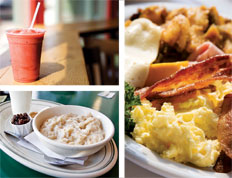About six months ago, ConAgra talked to 3,000 consumers about the first meal and found that most breakfast occasions fell into one of three categories.
The first category, which ConAgra dubbed an a.m. Pitstop, was basically a drive-by experience, a repast unfettered by such niceties as, say, chewing. The Pitstop breakfast patron has one goal and one goal only: to fill up and make tracks.
The company referred to the second, more civilized breakfast occasion as a Getaway Break. Diners who seek out the Getaway Break view their morning meal as a brief but necessary pause in their routines—a chance to relax, reinvigorate, and gear up for the rest of the pre-lunch hours.
The final group of consumers sees breakfast as a Personal Oasis. These are the consumers who either have more time or make more time to enjoy their mornings and savor breakfast fully.
There are ways for quick-serve menu-development professionals to use this consumer breakfast taxonomy to their chains’ advantage. Consider these possibilities:
Pitstop Picks When mulling the sorts of menu items that might appeal to the hurried consumer, think neat-to-eat, quick to prepare, and high-calorie and high-protein. What pitstop consumers need is fuel channeled through an efficient, tasty delivery mechanism.
It puts me in mind of a kind of edible funnel. Some clever chain out there will one day find success with a novel device we at the Center for Culinary Development have been seeing for some time. Imagine a line of edible breakfast cones—made from a variety of bread dough, sweet and savory alike—packed with choice breakfast fillings, from eggs, sausage, and cheese to oatmeal or fresh fruit and yogurt.
Another option might be to create a line of smoothies containing not just the traditional fruit juice and yogurt but also grains such as hearty steel-cut oats. This would provide a more balanced mix of protein and carbohydrates and would open up the smoothie landscape to include warm offerings—a heretofore largely unexplored breakfast frontier. Mexicans have long savored their atoles—grain-based beverages containing corn as well as sugar, cinnamon, milk, and other additions—but such comforting concoctions haven’t gained much ground in the U.S outside of southern Texas.
Getaway Breaks Consumers who treat breakfast as a getaway break want time to unwind or take a break. Today, these people eat breakfast sandwiches, pastries, and sweets—foods that are familiar, comforting, and often too much trouble to cook at home.
For these diners, a line of savory and sweet hot cereals might represent a healthier and more satisfying alternative to the usual morning fare. Hot grain-based porridges—from Cream of Wheat to corn grits—used to be staples of the American breakfast routine, and similar products, particularly those that are freshly made and made from proprietary recipes, could be popular again with additions like dried fruits and nuts.
Another area ripe for exploration: breakfast bread puddings. Think about it: A dish similar to French toast but eaten in a bowl using a spoon. The options would be virtually endless: cinnamon-maple bread pudding with a hot caramel sauce, chocolate bread pudding with a warm raspberry or strawberry sauce drizzled on top, banana bread pudding with raisins, dried cranberries, and brown sugar. That perfect mix of hot, hearty breakfast and sweetness would go down easy with getaway consumers.
Returning to the Oasis Those who enjoy the sort of schedule that affords the flexibility to enjoy breakfast at a leisurely pace may enjoy any or all of the above menu options, but they may also be seeking a personalized experience. My final suggestion for upping the breakfast hours’ drawing power is more of a technological one.
As it stands today, many chains offer a wide variety of popular combo meals that appeal to different tastes. But wouldn’t it be something if chains could give their regulars the option of creating any of several different personal breakfast combo meals and loading this information on a swipe-able card?
This way, the diner could hand his card to the cashier and say, “I’ll have my No. 4 today,” or “I’d like my No. 2 with a side of hash browns this morning.” This sort of system might lend itself to a smartphone application as well. Consumers could even order their personalized combo and have it ready for pickup when they arrive.
While chains have injected considerable creativity and ingenuity into their breakfast menu offerings in recent years, the ConAgra survey makes it clear that a one-size-fits-all approach to breakfast isn’t likely the best way to gain market share or turn first-time visitors into loyal customers. By taking a closer look at the needs of the three groups discussed here, chains could well innovate their way into consumers’ morning routines.











